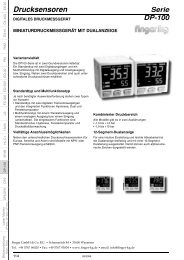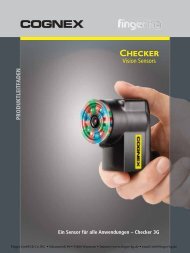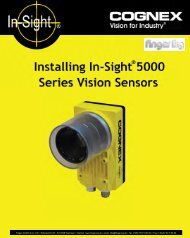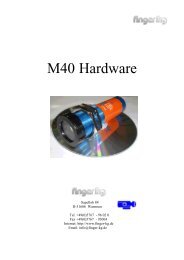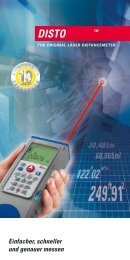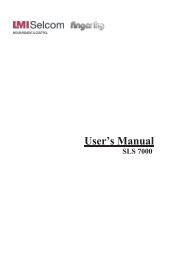TRIANGULATION LASER SENSORS, LDS603 Series Rev. G (26.06 ...
TRIANGULATION LASER SENSORS, LDS603 Series Rev. G (26.06 ...
TRIANGULATION LASER SENSORS, LDS603 Series Rev. G (26.06 ...
Create successful ePaper yourself
Turn your PDF publications into a flip-book with our unique Google optimized e-Paper software.
<strong>TRIANGULATION</strong> <strong>LASER</strong> <strong>SENSORS</strong>, <strong>LDS603</strong> <strong>Series</strong><br />
5.2. The sensor is positioned so that of object under control should place in this working range.<br />
Where objects to be controlled have intricate shapes and textures, the incidence of mirror component<br />
of the reflected radiation to the receiving window should be minimized. In addition, no foreign<br />
objects should be allowed to stay on the path of the incident and reflected laser radiation.<br />
Page 3/22<br />
6. CONNECTION<br />
Model Symbols D-sub 9-pin (fem) Wire color<br />
232-U/I-IN-AL Power U+<br />
Power U-<br />
TXD<br />
RXD<br />
U/I<br />
IN<br />
AL<br />
Gnd (Common for signals)<br />
232-CAN-IN/AL Power U+<br />
Power U-<br />
TXD<br />
RXD<br />
CAN_H<br />
CAN_L<br />
IN/AL<br />
Gnd (Common for signals)<br />
485-U/I-IN-AL Power U+<br />
Power U-<br />
DATA+<br />
DATA-<br />
U/I<br />
IN<br />
AL<br />
Gnd (Common for signals)<br />
<strong>Rev</strong>. G (<strong>26.06</strong>.2008)<br />
-<br />
-<br />
2<br />
3<br />
-<br />
-<br />
-<br />
5<br />
-<br />
-<br />
2<br />
3<br />
-<br />
-<br />
-<br />
5<br />
-<br />
-<br />
-<br />
-<br />
-<br />
-<br />
-<br />
-<br />
Red<br />
Brown<br />
Green<br />
Yellow<br />
Blue<br />
White/Violet<br />
Pink/Orange<br />
Grey/Black<br />
Red<br />
Brown<br />
Green<br />
Yellow<br />
Pink/Orange<br />
White/Violet<br />
Blue<br />
Grey/Black<br />
Red<br />
Brown<br />
Green<br />
Yellow<br />
Blue<br />
White/Violet<br />
Pink/Orange<br />
Grey/Black<br />
7. OPERATION MODES AND CONFIGURATION PARAMETERS.<br />
7.1. Measurement data from sensors can be obtained through serial interface and/or on the analog<br />
output. Through the serial interface measurement data can be obtained by both single requests<br />
(inquiries) and by automatic data streaming (see Section 7, ‘Description of serial interface’). When<br />
RS485 or CAN interfaces are used, several sensors can be connected to the data collection device<br />
through ‘common bus’ circuit (network operation mode).<br />
7.2. The nature of operation of the sensor governs its configuration parameters (operation<br />
modes), which can be changed by transmission of commands through serial port. The basic parameters<br />
are as follows:<br />
Sampling period — specifies the time interval (internal synchronization) or divider ratio of the<br />
trigger synchronization input for automatically refreshment of measurement results by the sensor.<br />
The value of the time interval is set in increments of 0.01 ms. If serial interface is used to receive<br />
the result and the time intervals set are small, the time required for data transmission at the selected<br />
data transfer rate should be taken into account. If the transfer time exceeds the sampling period, it<br />
wills this parameter, which will determine the data transfer rate.<br />
Sampling mode — specifies the type of sampling<br />
Finger GmbH & Co. KG • Schamerloh 84 • 31606 Warmsen • Internet: www.finger-kg.de • email: info@finger-kg.de



